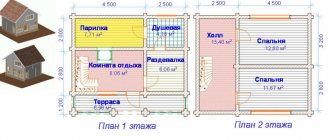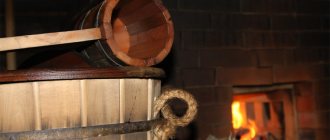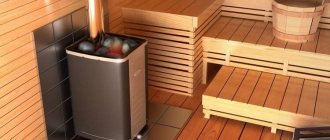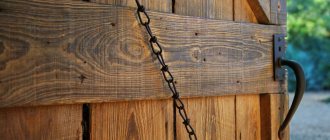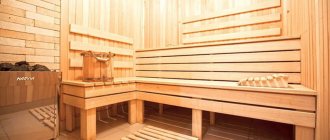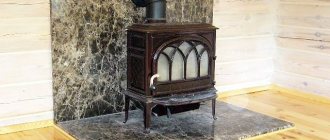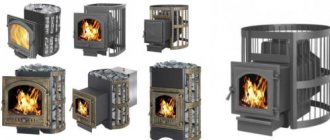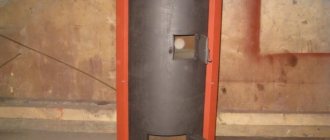What to consider
In addition to the direct dimensions of the working chamber, such indicators as the power of the firebox and the volume of the heater are taken into account, which is most often measured in the mass of loaded stones. The power of the stove determines what size steam room it will effectively heat, and the volume of the heater affects the amount of steam produced.
For kilns made independently, it is very difficult to calculate the optimal ratio of power to the number of loaded stones. Most often this is done experimentally. In factory-made models, everything is calculated, so the stones are guaranteed to warm up to the required temperature for the release of “white steam”.
Furnace device for hard coal and anthracite.
In order for the combustion process of coal to proceed normally, a significantly larger amount of oxygen is required than when burning wood. Therefore, the area of the grate should be larger than for firewood. Since when burning coal and anthracite, a higher temperature develops than when burning wood, the cross-section of the grate should be larger, which will avoid their deformation when heated. The walls of the firebox are lined with refractory bricks.
Anthracite is characterized by a small amount of volatile substances; in addition, the flame is small, so the volume of the firebox can be 1.5-2 times less than for firewood. The grate is deepened by 30 cm. The firebox for anthracite should be narrowed at the bottom above the grate, which will provide a thick layer of anthracite and increase the efficiency of fuel combustion. Holes are drilled in the valves so that after they are closed, gases can escape into the pipe.
Large size fireboxes
Large stoves have firebox dimensions of 73x73 cm. The power of such devices is 40 kW, which allows you to heat a steam room up to 50 m³. The maximum load of bath stone is 250 kg. In addition to a large amount of good steam, this makes it possible to steam for 6 hours without worrying about additional loading of firewood.
In addition, there is an original design of sauna stoves with a metal mesh around the firebox. The stoves have relatively small fireboxes for a bath, but can accommodate a large number of stones: the backfill is located around the chamber, and not just inside. This design warms up the room more slowly, but retains heat longer and produces more steam. Another advantage of stoves with a wire heater is that you can produce steam at different temperatures. When water is supplied to the lower part of the heater, hotter steam is released, and softer steam is released to the upper part.
What size should a metal sauna stove be?
The range of metal heating units for baths on the modern market is large. Usually these are steel or cast iron structures, which can be wood, gas, or electric. When buying a ready-made stove, you do not need to make any calculations. The manufacturer did this for you. The passport indicates the power of the device, dimensions and recommended room volume.
For a Russian bath, depending on the model, the dimensions vary: length from 400 to 680 cm, depth from 415 to 900 cm and height from 700 to 1600 cm.
Dimensions of the sauna stove: brick
Since the stove is built from brick, it cannot ignore its size. Therefore, the first thing you need to remember or rewrite for yourself is the dimensions of a standard red brick (250 mm length, 120 width, 65 height) - stoves are most often made from it (despite the fact that the inner core is usually made of fireclay).
With this data, you can easily calculate the length and width of any sauna stove if you have its order - just look at the very first row , which will show the number of lengths and widths of bricks on each side.
For example:
As for the height of the stove, you just need to count the number of rows in the masonry, multiply by the height of the brick, not forgetting to add 0.5 cm to each seam.
How to fold a stove with your own hands: step-by-step instructions (video)
A Russian stove in a country house is a stylish and efficient design that allows you to simultaneously heat a fairly large room and cook food in several modes. You can lay out a brick oven for free – with your own hands. To do this, you need to approach the work responsibly: calculate the dimensions of the furnace, draw a drawing and draw up the order of the structure. When carrying out masonry, you should take into account the recommendations of experienced stove makers. And then you will be able to make a reliable and durable new structure and replace the old stove!
Primary requirements
As mentioned above, furnace fireboxes are available in any design. If the combustion chamber meets all regulatory and technical requirements, then the home owner does not have to worry that the design will consume a lot of fuel or poorly heat the house.
If you install modern stoves for a bathhouse or home, then they already have a properly thought-out system for convection of air flows in the area where the combustion process itself occurs. Moreover, they are equipped with spacious fireboxes that allow maximum storage of wood and coal, thereby saving fuel used, and at the same time being able to maintain a comfortable temperature in the house for as long as possible.
Based on the laws of physics, we can remember that a correct and high-quality combustion process occurs only if a sufficient amount of oxygen penetrates into the chamber. To implement this option, many different designs have been developed, but the grate has remained the most popular for decades.
This product is made of cast iron, and is subsequently installed inside the combustion chamber. It serves to maintain the poured volume of solid fuel used during the combustion process. The grille has holes located along its base, which facilitate the penetration of air flows into the chamber. To improve traction, there is a blower, through which ash is also removed.
Typical firebox design
The location of the grate should be in the middle of the firebox of a stove for a bathhouse or a country house, slightly below the firebox door, approximately two bricks apart, and the horizontal holes are directed along the combustion chamber.
The slope of the grate is from two to five centimeters, which is determined by the size of the ovens. For better kindling and creation of proper draft, the element is mounted with a slope towards the chimney pipe. It is in this way that ideal conditions are created for uniform combustion of fuel inside a metal or brick stove, when the smoke flakes off the fire without collecting inside the firebox.
It is also important to observe this point: if the heating device is made of metal, then it is necessary to additionally design protection for the firebox so that it does not overheat, but in stone products, in order to build a chamber, it is better to use fireclay bricks that are resistant to high temperatures.
As for the fuel used, to purchase the required volume of material for the cold season, it is worth correctly calculating the number of days when the stove will burn, the area of the house and taking into account the thermal conductivity of the material. The highest indicators are coal (5500-6500 kcal/kg), peat gives off heat a little worse (2500-3500 kcal/kg), as well as firewood, but the latter must be dried under natural conditions.
Use of firewood
To correctly calculate the size and shape of the heating chamber, you need to focus on the height of the flame that comes from a particular type of fuel. If you can make a small firebox for coal, then larger dimensions are extremely necessary for peat and wood, since these substances burn actively.
Furnace device for peat.
The height of the firebox can be 70 - 80 cm. The dimensions of the grate depend on the degree of moisture content of the peat: when using dry briquettes, you can use the same grate as for firewood; for wet peat, the grate should be larger. The gaps in the grille should be no more than 8 - 10 mm.
The walls of the firebox should be inclined towards the grate. Since the combustion of peat produces a lot of ash, the ash pan should be larger.
For peat with high humidity, two grates are installed, this provides greater air flow. The height of the firebox in this case must be at least 80 cm, the width at least 40 cm. Holes are drilled in the valve.
Firebox size in a heating furnace
Firebox dimensions The width of the firebox in small stoves must be at least 20 cm, in large stoves - at least 30 cm. The height of the firebox, counting from the grate, must be at least 65 cm for peat, at least 80 cm for firewood, for coal - at least 70 cm. Place so much fuel in the firebox that there is at least 30 cm of free space between it and the top. If these conditions are not met, unburned fuel particles (soot) enter the chimney and settle there, becoming saturated with carbon monoxide. If a sufficient amount of soot accumulates in chimneys, poisoning (“burning”) with carbon monoxide is possible when the valve is closed.
Calculation of a stove for a bath: required power and firebox volume
No one doubts that the size of a sauna stove somehow depends on the power - the larger it is, the more fuel needs to be burned, the larger the size of the firebox or the number of heating elements should be. It is also true that power is a derivative of the size of the room to be heated. Therefore, the larger the room, the larger the oven.
Therefore, the first thing to do correctly is to calculate the power of the unit that can bring your stove to the desired mode in winter and summer in a reasonable time .
IMPORTANT! In principle, if you heat even a low-power stove for a very long time, it will still be able to heat the room, but this option is not considered, since the timing will obviously be “unreasonable.”
So, what is a “reasonable time frame”? A brick oven takes a long time to heat ; it definitely won’t take less than 4 hours. A metal one can handle it in half an hour to an hour (depending on the time of year and ambient temperature). That's how we'll count it somewhere.
First, let’s establish what matters when heating:
- presence of thermal insulation on the walls;
- temperature outside the window.
Therefore, for a bare log house without thermal insulation and even without clapboard finishing, you will have to add increasing factors. And in winter the bathhouse is always heated longer than in summer - at the same power.
For the initial calculation, you can also start from the volume of the room. Divide it by two - you get a very relative number of kilowatts required from the stove. Next is just multiplication, because you also need to heat the unit itself, the stones in it, someone needs to heat the water for the washing machine, and some of the heat produced will definitely fly away into the chimney. Therefore, we safely multiply the resulting kilowatts by 2.5-3. And this will be a figure that is true for a somewhat heat-insulated steam room that is not combined with a washing room. Other information about steam room stoves is presented in the corresponding article.
If there is no thermal insulation, just a bare frame, multiply the total again - now by 1.5.
If your stove has to heat not only the steam room, but also the adjacent rooms, then skip the last step , return to the data of the penultimate multiplication and multiply it by 2. This power should be enough for the adjacent ones.
Attention! Unfortunately, it is worth recognizing that most calculations of this level are extremely approximate.
However, without more precise odds, we will continue. Our task is to calculate the combustion volume of a wood-burning stove that would correspond to the required power . In principle, you can calculate the required number of heating elements yourself - it’s much easier, because the power of each heating element is known.
So, the volume of the firebox depends on the power of the unit as follows:
Furnace power = 0.5 or 0.6 * firebox volume in liters,
where
Firebox volume = furnace power: 0.5 or 0.6.
As you can see, you can roughly estimate the combustion volume of the firebox as twice as large as the required power.
All that remains is to extract the cube root to get an idea of the linear dimensions of the firebox. After this, you can already imagine the size of the sauna stove (according to the chosen design).
By the way! Do not think that such information is needed only by those who make their own sauna stove. It will be useful both if you indicate the data in the unit’s passport, and when you just want to check the advertisement of the stove you like.
Well, it's time to move on to specifics. Let's look at the linear parameters of the most interesting models that have already been mentioned in our ratings.
Russian stove with flood chamber: how to lay it
The Russian stove with heating is a modern, reliable design aimed at performing several functions. The design of the stove with heating allows you to cook food both on a cast iron stove and in a crucible, and heat a room of up to 60 square meters. m. It looks traditional, which makes it most suitable for rustic-style interiors.
In order to assemble a Russian stove with a flood chamber you need:
- Lay out the base of the pipe, small and large baking sheets in the first row.
- Form the second and third rows in the same way with space for the ash pan in the last one.
- Start laying the fourth row from a ledge (as in a conventional structure).
- In the fifth row, you should close the ash pan, and in the sixth, install a grate and lay a flue (if the stove is both wood- and gas-fired).
- Create a space for the firebox in the seventh row.
- Lay out the eighth and ninth rows with hewn bricks.
- Block the chimney in the tenth row.
- Lay out the pipe.
The finishing of the finished stove may include painting. You can paint the firebox or the roof of the furnace so that the furnace turns out to be fabulous. It is better to use traditional colors and motifs.
Features of operation
ATTENTION! If you have never exposed the structure to use, it must be dried after completion of construction.
This issue should be approached carefully and painstakingly. Then give the device time to burn out for one and a half to two hours. First light a small fire inside. The presence of an air lock will be determined by the appearance of smoke . In this case, it should be removed as follows: in the evening, create a small flame on the view.
This procedure should be done throughout the week. It is advisable to increase the number of chips or splinters placed every day. When there is not a single wet streak left on the bricks, this will mean that your invention is completely dry. Handling the stove requires its own skill everywhere. This applies to both tossing logs and ignition.
Subscribe to our Social networks
